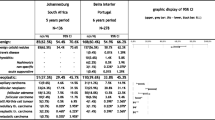Abstract.
Between 1963 and 1990, Austria had iodized salt prophylaxis of endemic goitre with 10 mg KI (7.5 mg I) per kg. This was obviously insufficient, as urinary iodine excretion ranged from 42 to 78 μg I per g of creatinine and goitre in adults remained in the endemic range of 15%–30%. Therefore salt iodization was doubled in 1990. The aim of this study was to assess the annual incidence of different types of hyperthyroidism (HT) before and after this increase in salt iodization. The incidence of HT was recorded in 14 nuclear medicine centres from 1987 to 1995. In five additional centres data were available from 1992 onwards. Data prior to 1992 were documented retrospectively, while those after 1992 were recorded prospectively. The 14 centres drew patients from an area with a population of approximately 4.23 million while all 19 institutes were estimated to cover an area with a population of 5.4 million (the total population of Austria is 7.86 million). A total of 414232 persons were examined for the first time in the participating centres. HT and the type of HT were defined by clinical examination, serum TSH, thyroid hormone levels in blood, ultrasonography, scintigraphy and serum autoantibody titres. HT was classified into immunogenic HT (Graves’ or Basedow’s disease, GD) and HT with intrinsic thyroid autonomy (uni-, multinodular or disseminated Plummers’ disease, PD). HT was also divided into overt (o) or subclinical (sc) disease. The following data were calculated: annual incidence per 100000 and the relative risk (RR) for HT with 95% confidence intervals (CI). In addition, linear trends were calculated for each type of HT by means of logistic regressions. In the 19 centres a total of 47834 patients with HT were registered from 1987 to 1995. PD accounted for 75% of all cases of HT and GD for 19%, while other types of HT were present in 6%. From 1987 to 1989 (time period T0), the annual incidence of oPD was 30.5 (95% CI 29.6-31.5) per 100000. The RR compared to the baseline period T0 was highest in 1992 (1.37; 1.3-1.45) and decreased to 1.17 (1.1-1.24) in 1995. The annual incidence of scPD in T0 was 27.4 (26.5–28.3) per 100000. The RR was highest in 1991 (1.64; 1.56-1.73) and was 1.60 (1.51–1.69) in 1995. In oPD and scPD a higher RR was observed in persons older than 50 years of age, particularly in men. The incidence of oGD in T0 was 10.4 (9.8–10.9) per 100000; the maximum RR increased to 2.19 (2.01-2.38) in 1993 and decreased to 1.95 (1.78–2.13) in 1995. The incidence of scGD was 1.9 (1.6-2.1) in T0. The maximum RR was observed in 1994 (2.47; 2.04-3.0) and it was still 2.26 (1.85–2.77) in 1995. The increased incidence of oGD and scGD was evenly distributed in all ages and both sexes. The time course of different types of HT following the increase in salt iodization could be divided into two phases: an increase in the incidences of HT with peaks after 1–4 years and a subsequent decrease, the only exception being scGD. The effect was more pronounced in GD than in PD. PD showed an age and gender dependency over time, while GD did not.
Similar content being viewed by others
Author information
Authors and Affiliations
Additional information
Received 1 December and in revised form 15 December 1997
Rights and permissions
About this article
Cite this article
Mostbeck, A., Galvan, G., Bauer, P. et al. The incidence of hyperthyroidism in Austria from 1987 to 1995 before and after an increase in salt iodization in 1990. Eur J Nucl Med 25, 367–374 (1998). https://doi.org/10.1007/s002590050234
Issue Date:
DOI: https://doi.org/10.1007/s002590050234




